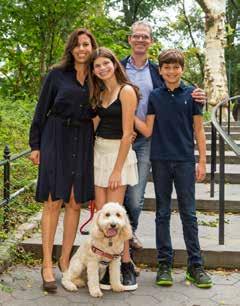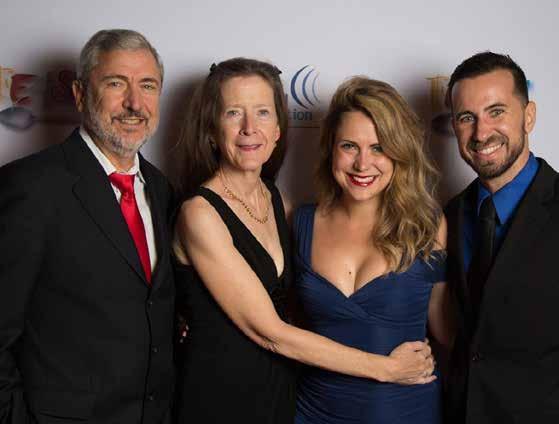
5 minute read
Managing Hearing Loss Travel
Travel Gets Easier for Telecoil Users
In the past couple of years there’s been an explosion of what could be industry-altering hearing loop news in the field of transportation, ready to go for us for when we’re all fully back on the road. By Stephen O. Frazier
Advertisement
Hearing loops have been available in the U.K. for years, in airports, train stations, the Underground, and even London taxicabs. They’re now becoming more plentiful in transportation systems here in the U.S. Recent announcements of new hearing loop installations and major plans for their future use in the field of transportation have pushed this time-tested technology to the forefront in efforts to accommodate the special needs of travelers with hearing loss.
A hearing loop is a wire that surrounds a defined area and is connected to an electronic sound source such as a public address system. It emits a silent electromagnetic signal that carries the sound from its electronic source to receivers called telecoils (T-coils) in hearing aids or cochlear implant (CI) processors. The majority of hearing aid models currently on the market have (or can be fitted with) telecoils. CI processors also generally come fitted with telecoils, varying by manufacturer.
My hearing aids and their telecoils are already optimized to match my audiogram and provide an extra boost to those frequencies I have the most difficulty hearing. Turning them on is simple: In a looped setting I just touch a button on my hearing aid and I’m instantly connected to the loop and its signal. Any number of telecoil users in a room can access the signal from the loop, something that is not possible with Bluetooth, which is basically a 1-to-1 system.
Here are some highlights: » The list of airports offering one or more forms of hearing loop technology in their terminals in the U.S. grew from 12 to 20 in just the past year or so. Among those added to the list were the major hubs of LaGuardia Airport in New York City and Los
Angeles International Airport. Memphis International is looping the departure gates in a new concourse now under construction, and, thanks to a grant from the Federal Aviation Administration, the Billings, Montana, airport will be including hearing loops in upgrades to their two terminals. In addition, the airports in
Minneapolis and Phoenix, both major hubs that already offered the technology, are expanding its presence at a variety of locations within their terminals. » New York’s Metropolitan Transit Authority (MTA) is testing looped city buses. A Hearing Loss Association of America NYC chapter member who volunteered to test says, “We were able to hear announcements from both the bus driver (live) and from outside My hearing aids and their telecoils are already optimized to match my audiogram and provide an extra boost to those frequencies I have the most difficulty hearing. Turning them on is simple: In a looped setting I just touch a button on my hearing aid and I’m instantly connected to the loop and its signal. Any number of telecoil users in a room can access the signal from the loop, something that is not possible with Bluetooth, which is basically a 1-to-1 system.
Adventures in Looping, Near and Far
Since the advent of COVID I’ve not strayed much outside of Albuquerque’s Rio Grande Valley but previously, en route to Paris via Madrid, I listened to Plácido Domingo through my personal (don’t leave home without it) neckloop instead of the offered earbuds on an Iberia Airlines flight. In Paris I used a neckloop for a self-conducted tour of the catacombs under Notre Dame. There was a counter loop at the tourist office in tiny Les Eyzies in rural France, and upon my departure I experienced the loop in a waiting area at Charles De Gaulle Airport. Across the Channel, I used my neckloop in place of the offered earphones with the receiver they provided to hear the prerecorded messages at each of the monolithic stones at Stonehenge in the English countryside.
I’ve also been able to talk with agents at subway information/fare booths and at Penn Station in New York City. A theater-provided neckloop let me hear and understand the dialogue in the award-winning “Kinky Boots” musical on Broadway. I regularly attend Hearing Loss Association of America conventions and, of course, all of the meeting rooms are looped so even if I sit in the back row it’s as though I have a front row seat. And at home in Albuquerque there’s a plethora of opportunities to use my telecoils. —S.O.F.
(recorded). The sound quality varied between the two sources, but both were pretty good.” » The MTA board has approved the funding for over 500 new subway cars dubbed the R262 model that will be fitted with hearing loops. » The MTA has also tested the installation of a hearing loop at the busy Bowling Green subway station in lower Manhattan. » In July 2021 Amtrak signed a $7.3 billion contract for 83 new train sets (expected to be six cars each) to be built by the German company Siemens in their California plant. They will be fitted with hearing loops and used on the line’s heavily traveled Northeast Corridor routes. » The Port Authority of New York and New Jersey announced a set of new accessibility requirements for all transportation terminals it operates. The requirements mandate the inclusion of hearing loops at departure gates and information booths at all new or significantly upgraded airports and at the information counters at rail, bus, and ferry terminals as well. » Also recently San Francisco’s Bay Area Rapid Transit
System (BART) took delivery of a fleet of hearing loop–equipped rail cars and completed the installation of hearing loops at all 50 of the system’s stations.
Prior to these recent developments, hearing loops had already found their way into other travel-related facilities such as New York’s Penn and Grand Central stations, the Intermodal station in Milwaukee that serves short and long distance train and bus passengers, and even New York City taxicabs. The Rail Vehicles Access Advisory Committee had made a recommendation to the U.S. Access Board to encourage the appropriate federal agency to require that all future rail cars be equipped with hearing loops.
All of this points to a future where travel will be just a little bit easier for people who have the little copper telecoils in their hearing aids or cochlear implant processor.
Trained by the Hearing Loss Association of America as a hearing loss support specialist, staff writer and New Mexico resident Stephen O. Frazier has served HLAA and others at the local, state, and national levels as a volunteer in their efforts to improve communication access for people with hearing loss. Contact him at hlaanm@juno.com. For more, see sofnabq.com and loopnm.com. For references, see hhf.org/summer2022-references.
Share your story: Tell us where you use hearing loops at editor@hhf.org.










